Wildflowers in Greene
Springtime in Greene County brings the rain, and with that rain comes the blossoming of the many wildflowers indigenous to the area. Reds, pinks, yellows, blues and purple shine against the greens of emerging plants and budding trees. If you’re looking for a reason to get outdoors this spring, consider a guided (or unguided) wildflower walk. Two wildflower walks will be held in the area: The Mason-Dixon Historical Park will hold a walk, along with a ramp dinner, on Saturday, April 26th at 1:15pm, and the Enlow Fork Natural Area Wildflower Walk will be held Sunday, April 27th, beginning in the early morning and running into the afternoon.
The Enlow Fork Natural Area is a sanctuary for blue eyed Marys. The bicolored blooms feature two white lobes on top and three blue lobes on the bottom; only two lobes on the bottom are visible. Stems have approximately four to six half-inch flowers. Blue eyed Marys grow from six to 24 inches tall in southwestern Pennsylvania’s rich woodland areas.
The wild geranium is found in both dry and moist woodland areas, growing in areas that receive sunlight. The five-petaled, purple-pink flowers grow in loose clusters to a height of one to two feet.
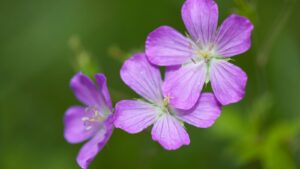
Trilliums are among the first flowers to appear each spring, with some species blooming in early to mid-March. Pennsylvania is home to seven species of trillium, from common to rare. The most common ones are the large-flowered trillium and red trillium. As spring turns to summer, the brilliant white petals of the large-flowered trillium fade to a light pink. These three-petaled flowers are often found in rich, moist soil of forests and along roads.
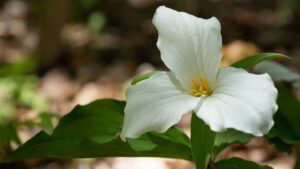
The delicate, nodding Virginia bluebell is found in moist woodlands and river valleys. It’s light blue-purple bell-shaped blooms last about three and grow in clusters. Individual flowers are about one inch long. They grow from eight to 24 inches tall. Mason-Dixon Historical Park features a Bluebell Trail, the perfect way to glimpse these flowers in April and May.
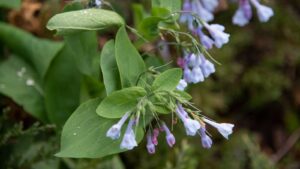
The tiny bluet grows in tufts, often covering broad areas of the ground. The delicate flowers are pale blue with yellow centers with four petals. Bluets grow from two to six inches high, and blossoms are about half an inch. Bluets can bloom from April until July, so you can enjoy them through much of the Spring and summer seasons.
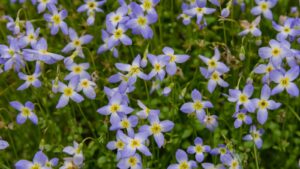
You can find multiple varieties of violets in Greene County. These low-growing splashes of deep to light purple, yellow, and white can be seen in woodlands, fields, and even in your own backyard. Violets are known for their five petals, with three on the bottom and two on top. The common blue violet, frequently found in yards, grows in abundance throughout the state. Other violets found in the area include the smooth yellow violet,
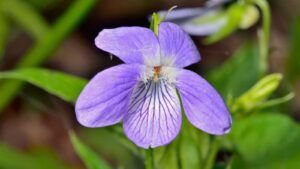
The five bright red petals of the fire pink are sure to catch your eye on a walk through Greene’s natural areas. They bloom mid-spring but may continue until mid-summer in the right conditions. Flowers are usually around 1.5 inches and the plants grow approximately 1 foot tall.
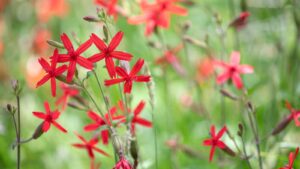
Western Pennsylvania is home to both the common yellow and rarer white trout lilies. Trout lilies are found growing moist woodland areas. The nodding flowers comprise three petals and three petal-like sepals, all curving backwards. Often found in sizeable colonies, each stalk features a single flower.
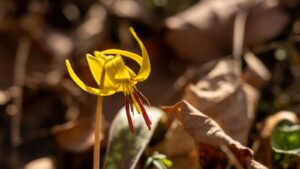
Various species of larkspur are found in Pennsylvania. Among them, the tall larkspur, growing up to six feet tall, is one of the later bloomers, with deep purple flowers blooming from July to September. Dwarf larkspur, or spring larkspur, is from eight to 30 inches tall, with anywhere from six to twenty-four flowers per plant. The deep purple, star-shaped flowers bloom early in the spring and can be hard to spot against dark backdrops.
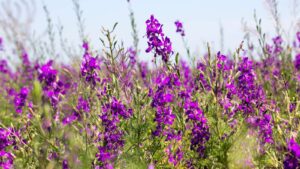
The varieties of phlox grow in a range of colors, including shades of pink, purple, blue, and white. Phlox grows in clusters of five-petaled flowers, and often a favorite for those wanting to plant native plants in their gardens.
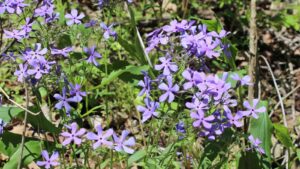
The unique Dutchmen’s breeches features white, V-shaped flowers that look like pants hanging upside down from a washing line. The flowers are usually less than an inch big and often grow in a row from a single stem. The blooms feature two smaller yellow petals at the bottom.
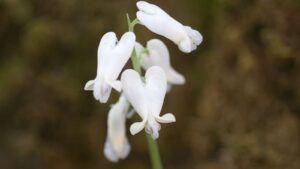
Seen less often than other varieties of native flowers the wild columbine has red and yelling bell blooms with curving spurs. The drooping flowers are about one to two inches long and the plant grows from one to two feet tall in woods and on slopes.
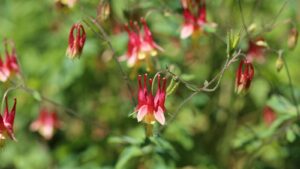
The white, eight-petaled twinleaf plant grows up to three feet tall, from March to May. The plant features a distinctive single leaf split into two parts that look like butterfly wings. It grows in moist woodland and its blooms are delicate and easily damaged.








